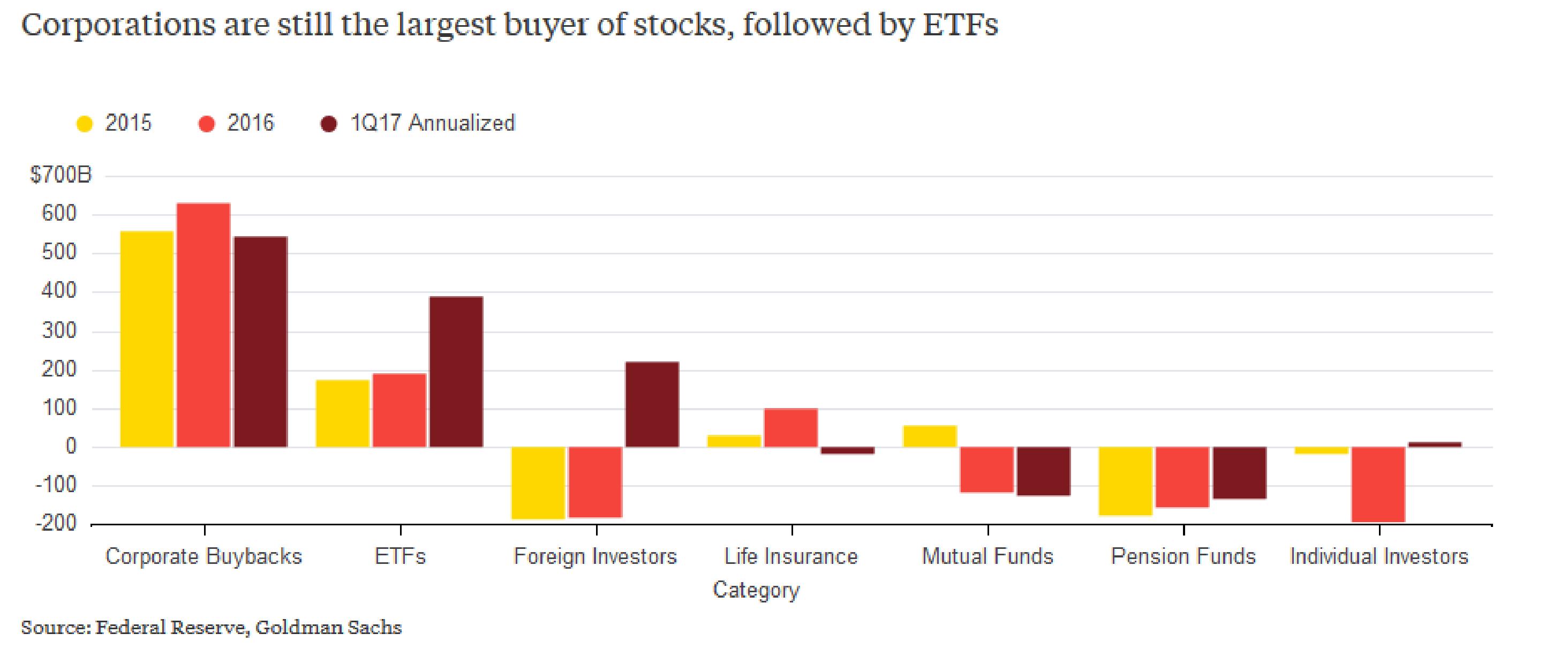The Daily Escape:

Marble Caves, Patagonia – photo by Clane Gessel
Any idea which investor-types are the largest buyers of US stocks? It is the corporations themselves, buying back their own stock. They are followed by Exchange Traded Funds (ETFs). Here is a graphic:
 From Bloomberg:
From Bloomberg:
The entities shoveling more money into the stock market than any other this year, as has been the case for the past few years, remain corporations. Buybacks are on pace to reach nearly $550 billion, or $150 billion more than ETFs.
None of that cash is going into new markets, new products, R & D, or innovation. The buyback is equivalent to the CEO saying: “I’ve got no idea what we should be doing to improve profits or market share”. Arne Alsin at Forbes said this:
For most of the 20th century, stock buybacks were deemed illegal because they were thought to be a form of stock market manipulation. But since 1982, when they were essentially legalized by the SEC, buybacks have become perhaps the most popular financial engineering tool in the C-Suite tool shed. And it’s obvious why Wall Street loves them: Buying back company stock can inflate a company’s share price and boost its earnings per share — metrics that often guide lucrative executive bonuses.
Alsin suggests that buybacks are big because we’re in a period of technological disruption. New industries like cloud computing, electric cars, and streaming video are rapidly changing the world. But older companies are slow to adapt, and rather than investing in R & D (or simply holding onto cash) the corporate boards of legacy businesses are bolstering stock prices the only way they know how: buying back their stock.
Alsin offers Hewlett-Packard as an example:
In the last decade, the company has invested $47 billion in stock buybacks — which is nearly double the company’s current market capitalization. That risk is senseless. HP knows they are facing existential threats from upstart competitors, but instead of paying out dividends or letting cash accrue on the balance sheet, HP is choosing the riskiest option.
Buybacks are the result of several converging forces: pressure from activist shareholders; executive compensation programs that tie pay to per-share earnings and share prices that buybacks can boost; increased global competition; and fear of making bets on products and services that may not pay off.
This financialization of non-financial firms increasingly crowds out other types of investment, to the detriment of lower level employees, whose jobs are less secure. It can hurt long-term investors, who hold these stocks in their 401(k)s and pension plans.
Serving customers, creating innovative new products, employing workers, and taking care of the environment are not the objectives of these firms.
So think carefully about the companies you invest in, or buy from.
Enough worrying for this week! Time to unstress. Grab a cuppa Vermont Artisan Coffee & Tea Company’s “Darkest Roast”, $11.25/lb. (It is available in decaf), settle into your favorite chair, and listen to “Ashokan Farewell” performed by Jay Ungar and Molly Mason Family Band, live in the Folk Alley studio at WKSU 89.7 FM. WKSU is Kent State’s college radio station:
Wrongo supports Folk Alley, and recommends that everyone should. Ungar composed Ashokan Farewell in 1982. It is written in the style of a Scottish lament. Ungar sometimes introduces it as:
A Scottish lament written by a Jewish guy from the Bronx.
Ungar says that Ken Burns heard the song in 1984, and asked to use it in his (then) upcoming PBS series, “The Civil War”. The original version and a few other versions are heard 25 times in the show, for a surprising total of 59 minutes and 33 seconds of the 11-hour series. For the non-math majors, that is 9% of the show!
Those who read the Wrongologist in email can view the video here.
